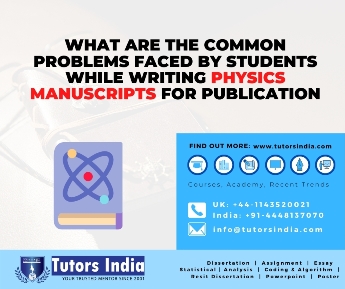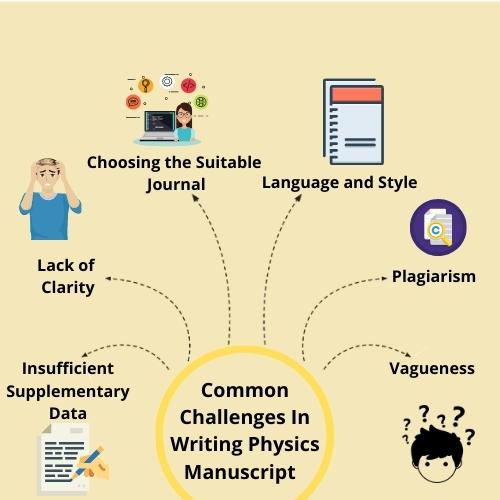What are the common problems faced by students while writing physics manuscripts for publication?
In Brief
- Must be careful about the language you are using in the proposal. It must be simple, as well as understandable.
- All physics writing projects must follow the appropriate structure; papers must be in the manuscript format; it generally follows API style manual 4th ed.
- ● Publishing is a long and complicated process. Many research works often fail due to lack of resources and lack of knowledge in identifying suitable academic publication. It arises when you fail to answer your research question.

Introduction
A research manuscript contains work done by the researcher submitted to the publisher for publication. Before writing a manuscript for publication decides your problem statement and summarizes the research work you are going to carry out in a few lines. When you have found the question and key message of your research, proceed with your manuscript writing. Extensive literature survey has to be done, to understand the research background. Hence, it is necessary to identify journals relevant to your research area, which is the main challenge faced by many of the students. The main goal in any manuscript writing is to clearly convey the information carried out by the author about the result of calculation and experiment and also to offer detailed thought of various physical theories, models and calculation. All physics writing projects must follow the appropriate structure; papers must be in the manuscript format; it generally follows API style manual 4th ed. If you need to publish your paper in an honour thesis, it requires some additional items like the signature page and table of contents. Honour thesis has particular formats of figures, tables and graphs inserted in the manuscript.
Choosing the Suitable Journal
It is necessary to choose a reputed academic journal publication. While choosing reputed journals consider the following factors
- consider the major topics published in the journal
- Group of readers following the journals
- Articles already published by the journal
- Impact aspects related to that journal
- The reputation of the authors who already published in the journal.
- Peer review process followed by the journal
- How long does the journal take for publication?
- access policy followed by the journal
You can hire a publication support service so that they can guide you to make a smart and well-versed choice about the right journal for your manuscript. Experts in top academic publishers can give you journal metrics and recommend 3-5 journals where you can publish your research work. Scientific & academic publishing always needs proper guidance. Journal publication Service will provide support to publish your research paper.
Language and Style
The major challenge faced while writing a manuscript is writing itself. Every journal follows a particular style of writing or own style guide, which may lead to paraphrase or some time even rewriting of the whole paper. Too many grammatical mistakes or linguistic errors will lead to manuscript rejection. Hence to publish any manuscript, it must be free from grammatical errors. The style of the manuscript is essential, i.e., format, font, outline, consistency. Overall the language used must be simple and must be in an understandable form.
Plagiarism
Plagiarism risk will affect the manuscript integrity and also author reputation. To prove the originality of the research work, it must be free from plagiarism. Discovering similarities and plagiarism is easier nowadays due to technology and computer software. Authors, editors, and publishers have to notice all the necessary concerns which leads to plagiarism. Sometimes even the publishing journal is likely to be fined for copyright infringements. There are various software tools which help to compare the written manuscript with other online publications.

Vagueness and Lack of Clarity
You must be careful about the language you are using in the proposal. It must be simple as well as understandable, the main aim of writing any manuscript is conveying your idea of research, your contribution over the research area and how much you have contributed to bringing improvement in that research field. Using complex words in a single sentence can affect the clarity of the proposal.
It also arises when you fail to answer your research question. A good proposal will show the reviewer that you know the particular research area, understand the problems and have an effective plan to address the issues that are rising in that specific research area.
Data inadequate
Supplementary data represent a visualization of data, i.e., adding charts, graphs, tables and other factors inside the manuscript. Without these data, it seems to be bland or overwhelming. Absence of these factors can also indicate your lack of research. So whenever you write a research proposal, try to add suitable literature and supplementary data. You must have enough data to prove your research work(sufficient data to justify your result). Inadequate data will lead to a failure of research. So it is essential to find necessary data before starting any research work.
Conclusion
Publishing is a long and complicated process. Many research works often fail due to lack of resources and lack of knowledge in identifying suitable academic publications. Publication support service will help the researcher to identify the right approach to publish their research successfully. If you are not confident in submitting your manuscript work for publication, you can get support from research paper publication support and editing and proofreading service.
References
- Huang, J. C. (2010). Publishing and learning writing for publication in English: Perspectives of NNES PhD students in science. Journal of English for Academic Purposes, 9(1), 33-44.
- Huff, A. S. (1999). Writing for scholarly publication. Sage.
- Mišak, A., Marušić, M., & Marušić, A. (2005). Manuscript editing as a way of teaching academic writing: Experience from a small scientific journal. Journal of Second Language Writing, 14(2), 122-131.

 Previous Post
Previous Post Next Post
Next Post